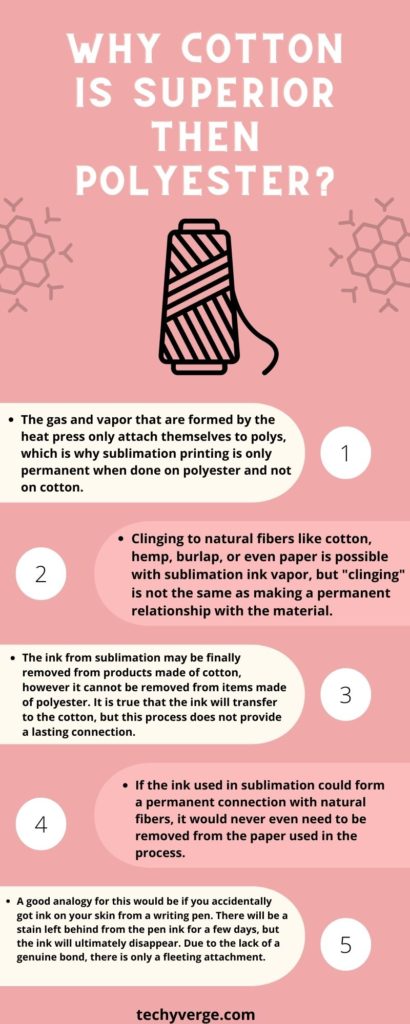Can Sublimation Be Removed? Removing undesired sublimation ink is a problem that must be solved as soon as possible, and someone needs to get on it because the person who discovers how to do it will undoubtedly become the ruler of the whole world.
What Exactly is Sublimation?
Let’s begin with a high-level overview, shall we? What precisely is meant by the term “sublimation”?
To put it more simply, it is a type of printing that involves using ink and heat to transfer a pattern onto a material or cloth.
It is a major change in fashion because it enables entire garment prints, which are patterns that extend from seam to seam across the garment.
Even if that’s a reach, don’t you think it would be nice to have the option of deleting the ink that’s been transferred through sublimation?
I do not doubt that we would! Whether or whether the results of sublimation are permanent or transient is wholly determined by the substrate, as described below:
Once anything has been sublimated and pressed into polyester or polymers, it cannot be removed. The sublimation will not be removed by bleaching the surface. When used on cotton, sublimation ink may be washed out after several cycles in the washing machine.
On hard substrates like poly-coated coffee cups, sublimation may be softened with high heat, but the only way to altogether remove it is to sand off the coating until you reach the ceramic below.
It is a good idea to test fresh ideas and new designs on random, discarded pieces of polyester since it is hard to erase/remove sublimation ink from poly-based blanks.
Before squandering a valuable and often expensive sublimation blank, you will have the opportunity to identify any design defects, color difficulties, and even size concerns that may arise from doing so.
Errors are inevitable no matter how much expertise you get, and everyone I know has tried everything possible to get rid of the ink left behind by sublimation. Still, none of their efforts has been fruitful.
Let’s begin by discussing the common blunders associated with sublimation and then go on to the key distinctions between sublimating on cotton, polyester, and poly-coated mugs and tumblers.
Why Is Permanent Printing Achieved Through Sublimation on Polyester but Not Cotton?
To begin, let’s try to grasp what exactly goes on during the sublimation process. To reduce this to its most basic level, your goal is to prevent the vapor from exiting the item.
The picture is transferred to the T-shirt when it is heated, and this causes the gas or moist vapor that is created throughout the process to move straight on top of the garment.
When it comes to sublimation, why cotton is superior to polyester?

The gas and vapor formed by the heat press only attach themselves to polys, which is why sublimation printing is only permanent when done on polyester and not on cotton.
Clinging to natural fibers like cotton, hemp, burlap, or even paper is possible with sublimation ink vapor, but “clinging” is not the same as making a permanent relationship with the material.
If the ink used in sublimation could form a permanent connection with natural fibers, it would never need to be removed from the paper used in the process.
The ink from sublimation may be finally removed from products made of cotton. However, it cannot be removed from items made of polyester. The ink will transfer to the cotton, but this process does not provide a lasting connection.
A good analogy would be if you accidentally got ink on your skin from a writing pen. There will be a stain left behind from the pen ink for a few days, but the ink will ultimately disappear. Due to the lack of a genuine bond, there is only a fleeting attachment.
Therefore, when you press sublimation ink into cotton, all that happens is that you leave a temporary stain on the cloth.
Conclusion
Ink is transferred onto a substrate using heat through sublimation. It is a popular fabric printing method, as it produces vibrant and durable prints. However, some wonder if sublimation is a permanent printing method or if the prints can be removed.
The answer to this question will vary depending on the substrate being used. If you are printing on synthetic fabric, such as polyester, the print will be permanent. Ink bonds with fabric fibers and is difficult to remove because it bonds with them.
However, if you print on a natural fabric, such as cotton, the print may be less permanent. This is because the ink does not bond well with natural fibers and may be more likely to fade or wash off over time.
In general, sublimation is a very durable printing method, and prints made with this method will last for many years. However, if you are concerned about the permanence of your print, you may want to consider printing on synthetic fabric. This will ensure that your print will be long-lasting and vibrant.
- Can You Sublimate on Nylon and Polyester? Which oneis the Best - February 19, 2024
- Converted Epson Eco Tank Et-2800 Vs Et-2803 Sublimation Printer [Review 2024] - February 19, 2024
- Can You Reuse Sublimation Prints? (The Righ Answer) - February 19, 2024


![Top 100+ FAQs Related to Sublimation Printing & Heat Press [Updated 2024] faqs related to sublimation Printing](https://www.techyverge.com/wp-content/uploads/2022/08/faqs-related-to-sublimation-Printing--150x150.jpg)



